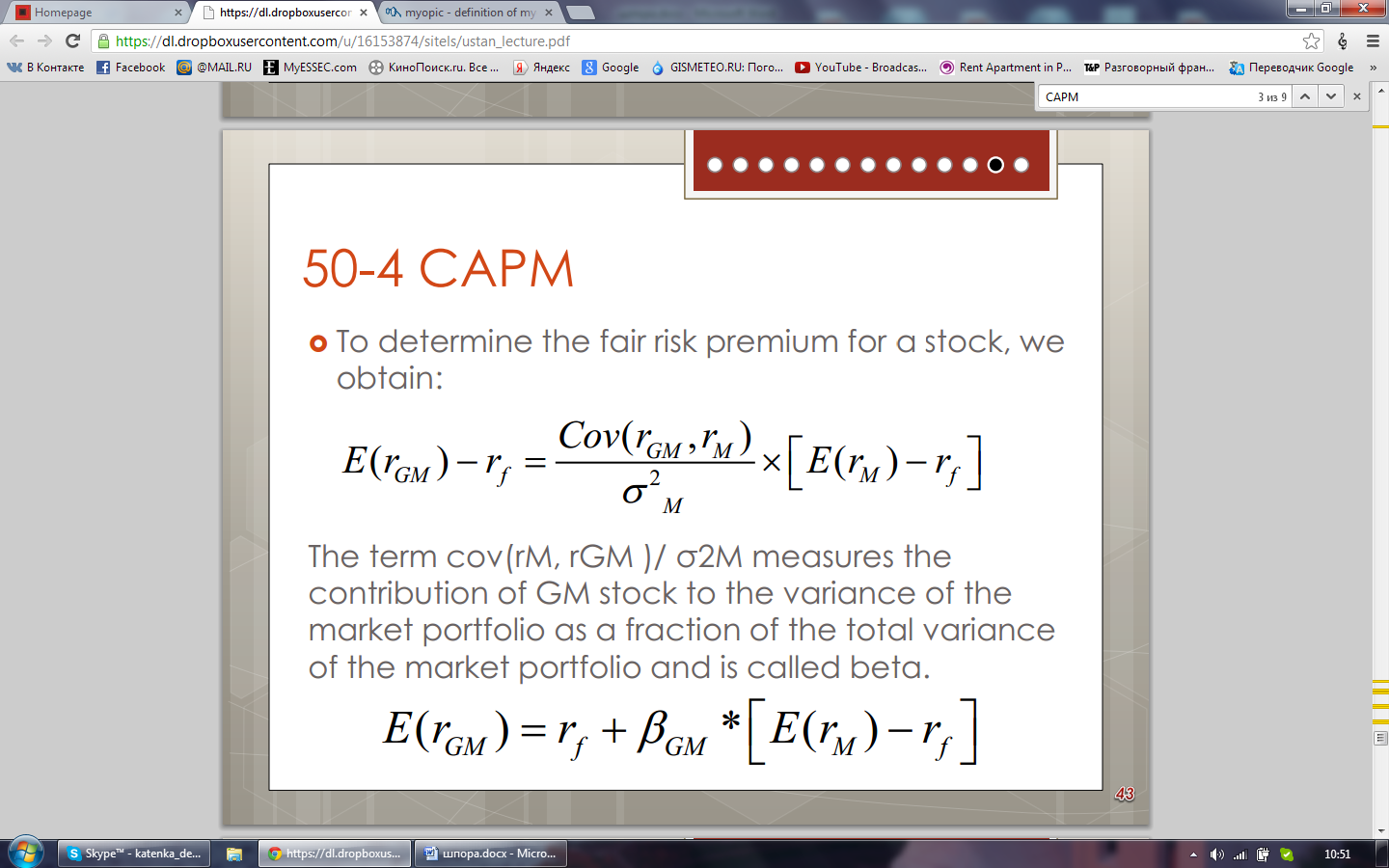Capital Assets Pricing Model (CAPM).
The question that the CAPM model tries to answer is what the relationship between return and risk is. This theory has the basic idea that the assets with the same systematic risk should give the same return.
The CAPM gives us a precise prediction of the relationship we should observe between the risk of an asset and its expected return. This relationship serves two vital functions:
· First, it provides a benchmark rate of return for valuating possible investments
· Second, the model helps us make an educated guess as to the expected return on assets that have not yet been traded in the marketplace.
CAPM has 6 assumptions:
· Perfect competition
· Myopic behavior (short-term planning)
· Universe of publicly traded securities
· No transaction costs, no taxes
· All investors are rational mean-variance optimizers (Max Er, Min Stand.Div)
· homogeneous expectations
CAPM Implications
· All investors will choose to hold the market portfolio
· The market portfolio will be on the efficient frontier
· The risk premium on the market portfolio will be proportional to the variance of the market portfolio and the market degree of risk aversion
· The risk premium on individual assets will be proportional to the risk premium on the market portfolio (M) and to the beta coefficient of the security on the market portfolio
To determine the fair risk premium for a stock, we obtain:

Beta is the calculated as: cov(rM, rStock )/ σ2M measures the contribution of stock to the variance of the market portfolio as a fraction of the total variance of the market portfolio and is called beta.
Beta measures a stock's volatility, the degree to which a stock price fluctuates in relation to the overall market. Investment analysts use the Greek letter beta, ß. It is calculated using regression analysis. A beta of 1 indicates that the security's price will move with the market. A beta greater than 1 indicates that the security's price will be more volatile than the market, and a beta less than 1 means that it will be less volatile than the market.
51. Approaches to measuring market risk. Long-term investments planning.
Market risk=possibility that future earnings could be adversely affected by change in market prices caused by movements in interest rates or exchange rates;
exposure to the uncertain market value of a portfolio. Market risk is managed with a ST focus. LT losses are avoided by avoiding losses from one day to next. Variety of risk metrics: duration and convexity, beta, etc. – for exposure assessment by portfolio managers. On strategic level, organizations manage market risk: applying risk limits to traders' or portfolio managers' activities. Value-at-risk used to define and monitor these limits. +sometimes stress testing to their portfolios applied.
Following Risk measures exist: measures of duration, measures of delta, etc.
Duration and convexity are factor sensitivities that describe exposure to parallel shifts in the spot curve. can be applied to individ fixed income instruments or to entire fixed income portfolios.
Duration: Suppose portfolio has a duration of 3 yrs. >portfolio's value will decline about 3% for each 1% increase in interest rates—or rise about 3% for each 1% decrease in interest rates ;summarizes most significant piece of info about a bond or portfolio's sensitivity to interest rates
Convexity:, convexity summarizes the second-most signif. piece of info. Duration captured the fact that spot curve was downward sloping. It did not, however, capture its upward curvature. Convexity describes curvature.
Value at risk =single, summary, statistical measure of possible portfolio losses.; a measure of losses due to "normal" market movements. Losses greater > than value at risk are suffered only with a specified small probability; value at risk aggregates all of the risks in a portfolio into a single number suitable for use in the boardroom, reporting to regulators, or disclosure in an annual report. Once hurdle of using a statistical measure crossed, concept of value at risk is straightforward to understand. =simply a way to describe the magnitude of the likely losses on the portfolio.
"stress-testing" = determining the change in value of his portfolio under stressful conditions, the portfolio manager has better perception of potential risks. ;can make trades that reduce risk to levels with which he is comfortable. Without "stress-testing" he will be forced to react in a moving market, a situation that can strenghten market losses. In a complex derivatives portfolio, stress-testing that reveals excessively risky exposures either to movements in the underlying cash rate or shifts in implied volatility or interest rates (or combinations of these) is said to identify "risk holes."
Risk limits =a device for authorizing specific forms of risk taking.
